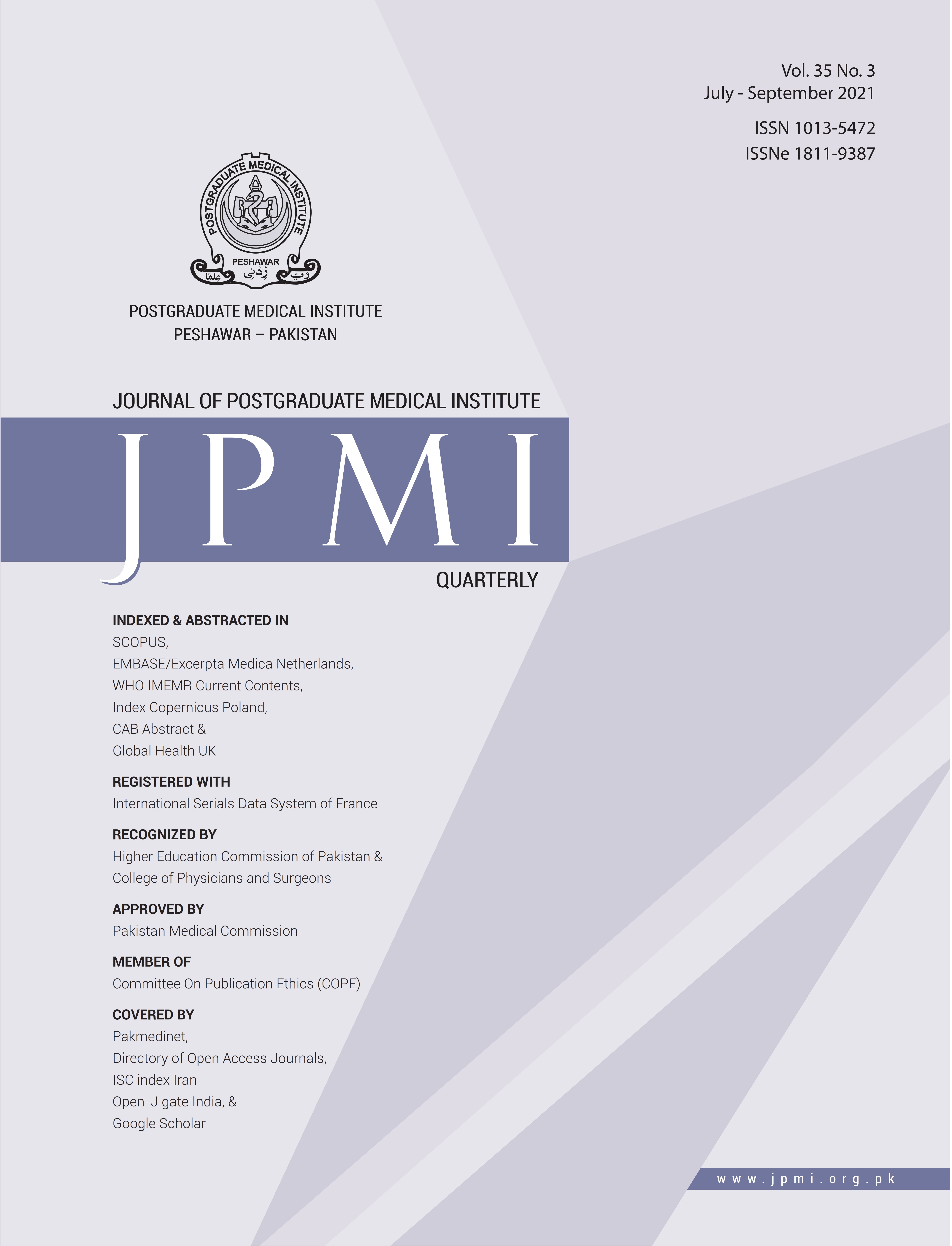PRESENTATION AND MANAGEMENT OF PATIENTS WITH OBSTETRICAL AND GYNECOLOGICAL COMPLICATIONS IN THE DEPARTMENT OF SURGERY
Main Article Content
Abstract
Objective: To find out the types of obstetrical and gynecological complications and their subsequent treatment in the department of general surgery.
Methodology: This cross sectional study was conducted on 56 patients who presented to department of surgery, Hayatabad Medical Complex, Peshawar from July 2016 to June 2019. Patients presented either as emergency cases with 24-48 hours following surgery or those who were referred to OPD 48 hours after the procedure. Emergency cases included postoperative complications during obstetrical and gynaecological procedures performed in the department of Obstetrics and Gynaecology of the same hospital, and those referred from peripheral hospitals. These emergencies were managed immediately while cold cases were operated on elective operation list. Patients were followed up in the OPD. Data was analyzed with SPSS version 20.
Results: Out of 56, 24 (42.8%) cases presented to accident and emergency department while 32 (57.2%) were referred to outdoor department (OPD). The initial surgeries, during which complications occurred, included total abdominal hysterectomy (n=34, 64.3%) followed by, pelvic mass excision (n=8, 14.3%) and cesarean section (n=8, 10.7%). The most common complication was wound infection (n=13, 23.2%) followed by haemorrhage (n=9, 16.1%) and incisional hernia (n=8, 14%). Debridement and dressing (n=13, 23.2%), haemostasis (n=9, 16.1%) and mesh repair (n=8, 14.3%) for incision hernia were the common operative procedures. There was no mortality in emergency as well as cold cases.
Conclusion: Total abdominal hysterectomy, cesarean section and vaginal hysrerectomy, being commonly performed procedures, are associated with high percentage of post operative complications.
Article Details
Work published in JPMI is licensed under a
Creative Commons Attribution-NonCommercial 2.0 Generic License.
Authors are permitted and encouraged to post their work online (e.g., in institutional repositories or on their website) prior to and during the submission process, as it can lead to productive exchanges, as well as earlier and greater citation of published work.
References
Gevariya R, Oza H, Doshi H, Parikh P. Epidemiology, risk factors and outcome of complications in obstetric and gy¬neacological Surgeries- A tertiary cen¬ter experience from western India. J US-ChinaMed Sci. 2015; 12:45-52.
Haynes AB, Weiser TG, Berry WR, Lipsitz SR, Breizat AHS, Dellinger EP, et al. A surgical safety check list to reduce mor¬bidity and mortality in a global popula¬tion. N Eng J Med. 2009; 360:491-9.
McPherson K, Metcalfe MA, Herbert A, Casbard A, Hargreaves J, Bridgman S, et al. Sever complications of hysterec¬tomy: The VALUE study. Br J Obstet Gy¬naecol. 2004; 111:688-94.
Das CM, Khursheed F, Majeed T. Sur¬gical related mor-bidity and mortality in patients referred to a tertiary level hos¬pital. World Appl Sci J. 2011; 13:1817- 20.
Bicker SW, Sanno-Duanda B. Epidemi¬ology of Peadiatric surgical admissions to a government referral hospital in Gambia. Bull WHO. 2000; 78:1330-36.
Yii, MK, Ng KJ. Risk adjusted surgical audit with the POS-SUM scoring system in a developing country. Physiolog-ical and operative severity score for the enumeration of Mortality and Morbidity. Br J Surg. 2002; 89: 110-3.
Chan YG, Ho HK, Chen CY. Abdominal hysterectomy: indications and com¬plications. Singapore Med J. 1993; 34:337-40.
Geetha K, Seethalakshmi B, Hameed J. Retreospective study of total abdominal hysterectomy versus vaginal hysterec¬tomy. J Evolution Med Dent Sci. 2014; 3:2768-73.
Taj A, Batool S, Yasmeen T. Analysis of morbidity associat-ed with total abdom¬inal hysterectomies for benign con-di¬tions. Pak J Surg. 2014; 30:159-62.
Vaidya B, Chaudhari M, Parmar D, Chaudhari V, Dagi-nawala T, Shah R. Bladder injuries during obstetrical and gynaecological surgeries. Int Surg J. 2017; 4:2177-80.
Ghazi A, Iqbal P, Siddique M. Bladder and ureter injuries during obstetrics and gynaecological procedures. Pak J Surg. 2008; 24:53-6.
Vakili B, Chesson RR, Kyle BL, Shobeiri SA, Echols KT, Gist R et al. The incidence of urinary tract injury during hyster-ec¬tomy: a prospective analysis based on universal cystos-copy. Am J Obstet Gy-naecol. 2005; 192:1599-604.
Chan JK, Morrow J, Manetta A. Preven¬tion of urethral inju-ries in gynaecologic surgery. Am J Obstet Gynaecol. 2003; 188:1273-7.
Jadoon S, Jadoon SMK, Karim F. A retrospective study of gynaecological hysterectomies at a teaching hospital in Pakistan. J Surg obstet Gynaecol Pak. 2015; 5:46-51.
Bashir R, Parveen Z, Sultana R, Khan B. A two years au-dit of complications of hysterectomies at Ayub Teaching Hospi¬tal Abbotabad. J Ayub Med Coll Abbota¬bad. 2005; 17:47-9.
Erekson EA, Yip SO, Ciarleglio MM, Fried TR. Postoper-ative complications after gynaecologic surgery. Obstet Gy¬naecol. 2011; 118:785-99.
Iftikhar R. Total versus subtotal abdom¬inal hysterectomy in benign uterine dis¬ease. J Surg Pak. 2007; 12:102-5.
Iftikhar R. Vaginal hysterectomy is su¬perior than abdomi-nal hysterectomy. J Surg Pak Int. 2008; 13:55-8.
Amin A, Ali A, Amin Z, Sani FN. Justi¬fication for hysterec-tomies and fre¬quency of histopathological lesions of hys-terectomy at a teaching hospital in Peshawar, Pakistan. Pak J Med Sci. 2013; 29:170-2.
Sivapragasam V, Rengasamy CK, Patil AB. An audit of hys-terectomies: in¬dications, complications and clinico¬path-ological analysis of hysterectomy specimens in a tertiary care centre. Int J Reprod Contracept Obstet Gynecol. 2018; 7:3689-94.
Verma D, Singh P, Kulshrestha R. Analy¬sis of histopatho-logical examination of the hysterectomy specimens in a north Indian teaching institute. Int J Res Med Sci. 2016; 4:4753-8.
Mikhail E, Miladinovic B, Velanovic V, Finan MA, Hart S, Imudia AN. Associa¬tion between obesity and the trends of routes of hysterectomy performed for benign indica-tions. Obstet Gynecol. 2015; 125:912-8.


